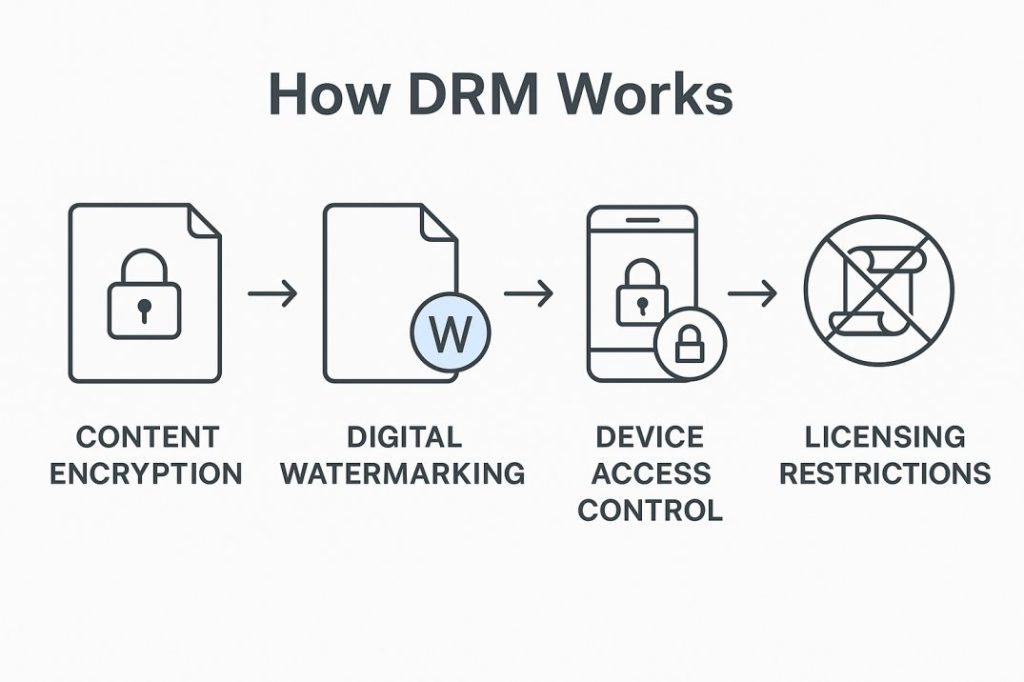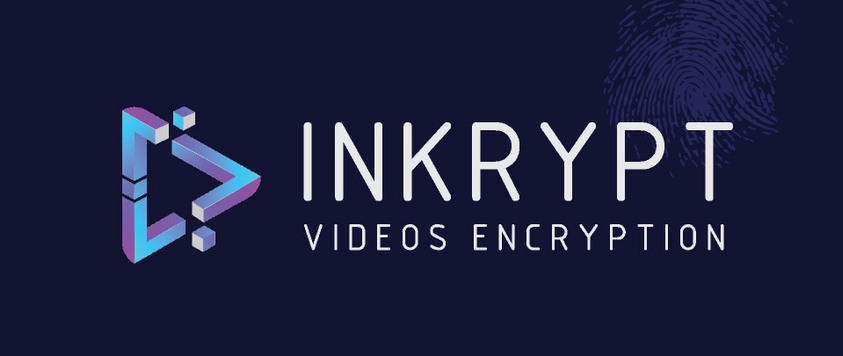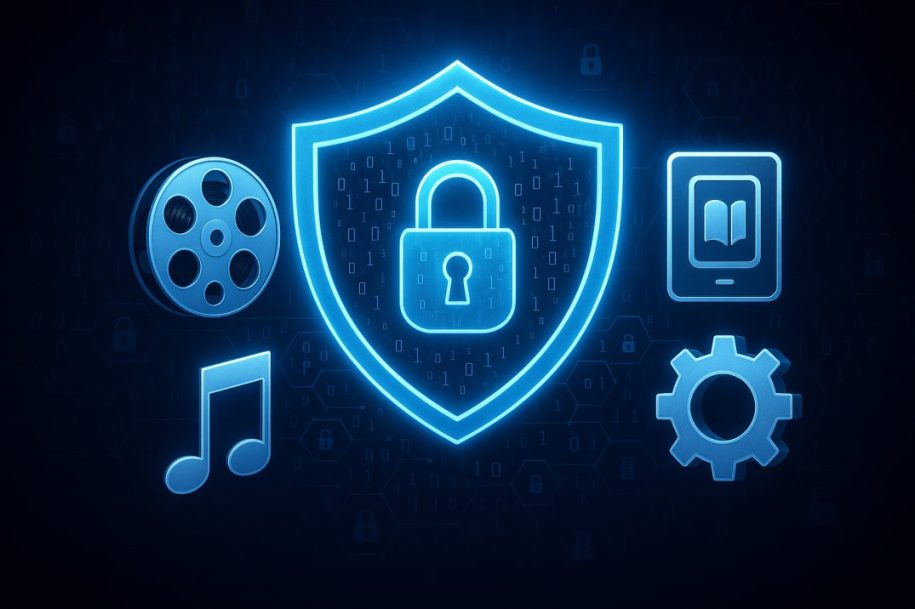Table of Contents
ToggleDigital Rights Management (DRM) is reshaping how we protect and share content online. Want to know how DRM safeguards creators while keeping user access fair? Let’s explore.
Key Takeaways
DRM Protects Digital Creativity: Digital Rights Management (DRM) ensures creators and distributors maintain control over how their content is used, accessed, and monetized across platforms.
Essential Across Industries: From streaming services and eBooks to corporate training and gaming, tailored DRM solutions prevent piracy and protect revenue in various sectors.
Core Technologies at Work: Encryption, watermarking, and rights control restrict unauthorized access, trace misuse, and enforce content policies.
Consumer Trust Through Control: DRM supports fair use for legitimate buyers, offering secure, high-quality experiences when implemented with user convenience in mind.
Criticism Drives Innovation: Overly rigid DRM once frustrated users; now, flexible solutions like multi-device access and biometric login are bridging the gap between protection and usability.
Future-Proof Strategies Required: Streaming growth, global regulations, and cross-sector collaboration are shaping next-gen DRM that balances piracy prevention with positive user experience.
Real-World Success Stories: Platforms like Spotify demonstrate how DRM can deter piracy while enhancing consumer satisfaction with offline access and multi-device support
Digital Rights Management (DRM)
Digital Rights Management (DRM) protection is crucial for creators and distributors to safeguard their intellectual property online. In today’s digital landscape, where content is easily copied and shared across the internet, DRM technologies help prevent unauthorized use and distribution. Understanding DRM’s significance highlights its fundamental role in the digital economy. It directly supports:
Securing content rights.
Enforcing usage policies.
Maintaining vital revenue streams for digital content.
Purpose and Importance of DRM
DRM’s core purpose is preventing unauthorized redistribution of digital media and restricting how users copy purchased content. This digital media protection is vital for industries frequently impacted by piracy and illegal distribution, such as:
Film studios
Music producers
Software developers
Digital media companies
These sectors often face substantial revenue losses without robust DRM solutions. By enforcing content copying restrictions, DRM ensures creators and rights holders get paid fairly. This financial protection directly supports funding new creative works and passion projects.
Understanding Key DRM Functionalities
DRM solutions encompass several core content protection technologies designed to control how digital items are accessed, copied, shared, and distributed. These DRM functionalities – including content encryption, digital watermarking, and complex rights management – work across devices like smartphones, tablets, e-readers, and PCs, securing content in both consumer (B2C) and enterprise (B2B) applications.
Here’s how essential DRM tools work:
Content Encryption: DRM systems encrypt files, preventing unauthorized access. Only users with the correct decryption keys can unlock and view the protected content.
Digital Watermarking: This embeds invisible identifiers directly into the content (like an eBook or movie). If unauthorized copies surface, the watermark traces them back to the source user, acting as a powerful deterrent against illegal sharing.
Complex Rights Management: These are granular rules specifying exactly how content can be used. Examples include limiting playback to specific devices, restricting the number of song plays, or setting expiry dates for access.

Effective DRM offers significant advantages for everyone in the digital content ecosystem: creators, distributors, and paying users alike.
For Content Creators:
Guarantee Fair Pay: DRM ensures you receive compensation for every legitimate sale or use of your creative work.
Maintain Distribution Control: Precisely manage how and where your content is accessed and shared.
For Distributors:
Enable Secure Content Delivery: Protect your digital inventory from leaks or piracy during distribution.
Gain Valuable Usage Insights: Track how content is consumed to inform marketing strategies and build stronger customer relationships.
For Paying Consumers:
Access Legally Protected Content: Know that your purchased or subscribed content is authentic and professionally managed.
Experience Consistent Quality: Benefit from reliable, high-quality interfaces and services supported by DRM security.
DRM Criticisms and Key Controversies
While beneficial, DRM faces valid criticism. The most common concerns include:
Overly Restrictive Controls: Critics argue some DRM systems excessively limit legal consumer rights, preventing full enjoyment of purchased content. For example, being unable to play music or videos on your preferred device or media player causes frustration.
Questionable Piracy Deterrence: Research debates DRM’s actual effectiveness against piracy. Studies indicate determined pirates often bypass protections, raising doubts about its real-world impact on unauthorized distribution.
The Evolving Landscape of DRM
DRM technology is evolving to better balance robust protection with user convenience. Modern flexible DRM solutions now offer more user-friendly access within legal boundaries, addressing past criticisms. Companies are actively innovating, developing consumer-friendly DRM applications that align with user expectations and find a fairer equilibrium between security and accessibility.
Future Trends Shaping DRM:
Streaming & Cloud Integration: The dominance of streaming services and cloud-based delivery demands adaptable cloud DRM solutions for new security challenges and opportunities.
Regulatory Influence: Global legislative and regulatory developments will critically define the scope and effectiveness of DRM protection.
Cross-Sector Collaboration: Continuous collaboration between technologists, legal experts, industries, and consumers is essential to forge effective systems.
Effective DRM remains vital for the digital media ecosystem’s future. Its evolution hinges on creating systems that protect creative works while safeguarding user rights and convenience.
Real-World DRM Applications: Industry Case Studies
DRM isn’t one-size-fits-all. Different sectors implement tailored DRM solutions to protect unique content and revenue streams. Here’s how key industries leverage DRM protection:
Streaming Media:
Platforms (Netflix, Spotify): Employ multi-layered DRM to block unauthorized downloads and sharing, guaranteeing only paying subscribers access premium movies, shows, and music.
Live Sports: Uses robust DRM to stop illegal rebroadcasts instantly, safeguarding exclusive broadcast rights and pay-per-view revenue.
Publishing:
eBooks (Amazon, major publishers): Apply file-level DRM to restrict copying, printing, and unauthorized sharing of digital books, directly protecting author royalties and publisher investments.
Education & Corporate Training:
Online Courses: Secure video lectures, quizzes, and materials with access control DRM, ensuring only enrolled students can view paid educational content.
Corporate Training: Protect sensitive internal manuals, product videos, and strategy documents using enterprise DRM, safeguarding proprietary knowledge and competitive advantage.
Software & Gaming:
License Enforcement: Implement activation-based DRM to restrict software and game usage to licensed users, significantly reducing piracy and protecting developer revenue.
Balancing DRM Security with User Experience
A key challenge in DRM implementation is maintaining robust content protection without frustrating legitimate users. Prioritizing this balance is critical for adoption and satisfaction.
Common DRM Pain Points:
Device limitations blocking content access.
Complex authentication or frustrating playback errors.
Inability to use purchased content across platforms.
User-Centric DRM Solutions:
Flexible Licensing DRM: Allow reasonable multi-device access (e.g., 3-5 authorized devices).
Frictionless Authentication: Implement single sign-on (SSO) or biometric login for seamless access.
Adaptive Access Controls: Dynamically adjust restrictions based on trusted user behavior.
Case Study: Spotify’s Balanced Approach
Spotify’s consumer-friendly DRM enables offline listening on multiple devices while preventing mass piracy. This demonstrates how flexible DRM policies protect content without compromising subscriber convenience.
Conclusion
Digital Rights Management (DRM) remains a cornerstone of modern content protection, enabling creators, distributors, and users to coexist in a secure, fair digital ecosystem. As technology evolves, so too must DRM, striking the right balance between preventing piracy and preserving user experience. The future lies in smarter, more flexible solutions that protect creativity without compromise.
Looking to secure your digital content with future-ready DRM solutions? Explore innovative tools and expert insights to protect your media—start building smarter protection today.
FAQs
DRM protection uses encryption and access controls to prevent unauthorized copying, sharing, and use of digital content like videos, music, ebooks, and software
DRM encrypts content and only allows playback on authorized devices or apps, ensuring that only subscribers can access premium media
DRM restrictions may limit playback to certain devices or apps, causing compatibility issues or requiring specific software to access the content
Circumventing DRM is generally illegal in many countries, even for personal use, due to copyright and anti-circumvention laws
DRM helps protect intellectual property, prevent piracy, control distribution, and ensure creators receive fair compensation for their work
Yes, DRM can restrict how content is used, limit device compatibility, and sometimes create access issues for legitimate users
Check the product details or platform information—DRM-protected content usually states usage restrictions or requires specific apps for access
DRM often requires periodic online checks, so some content may not be available offline or may expire after a set time
DRM is widely used for streaming video, music, ebooks, software, and online courses to prevent unauthorized distribution
Many users find DRM restrictive, as it can limit device choices and make it harder to enjoy purchased content freely
Platforms use multi-DRM solutions compatible with various devices and browsers, ensuring secure playback while maintaining broad accessibility

